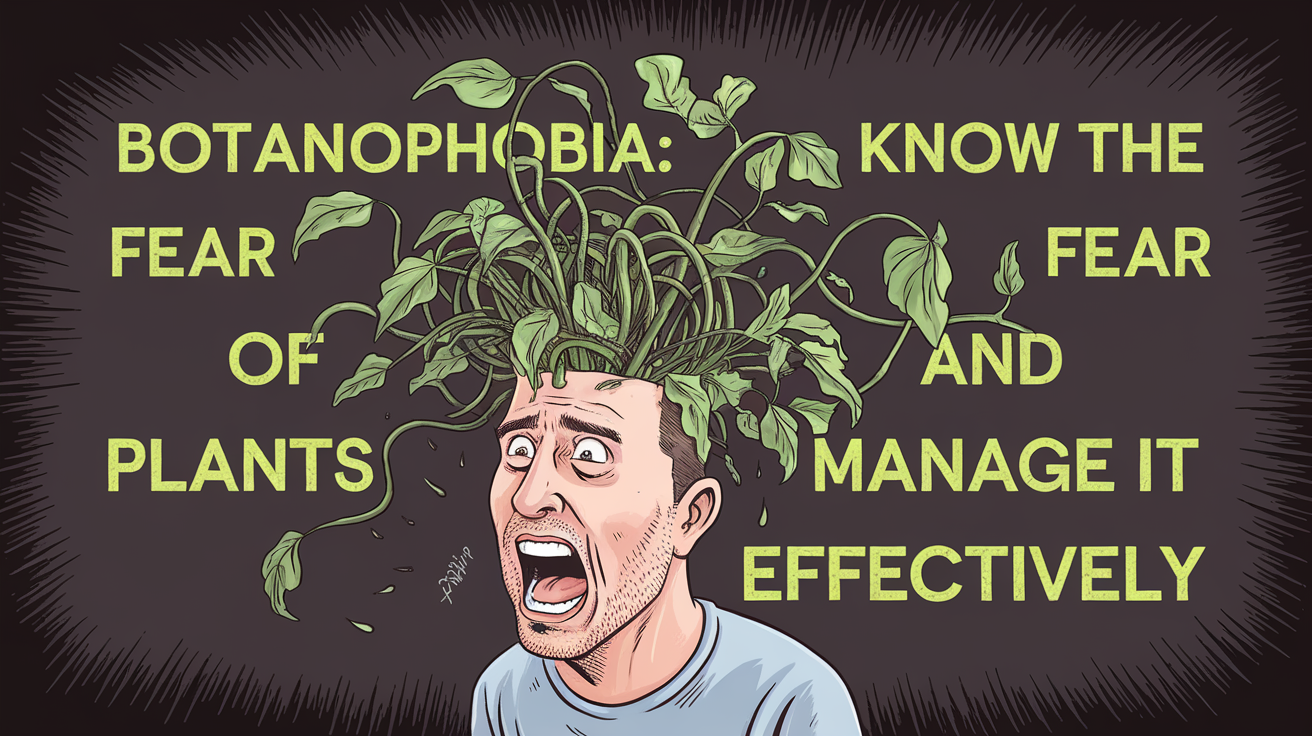
In a world where greenery is often associated with life, growth, and serenity, it may come as a surprise that some individuals experience intense fear and anxiety when confronted with plants.
This condition, known as botanophobia, is a specific phobia that can significantly impact a person’s daily life and well-being.
In this blog, we’ll know the intricacies of botanophobia, examining its symptoms, causes, etc.
We will also discuss various strategies for managing and overcoming this unique fear.
Let’s get started!
What is Botanophobia?

Botanophobia, derived from the Greek words “botany” (plant) and “Phobos” (fear), is an irrational and excessive fear of plants.
This phobia can manifest in various degrees of severity, ranging from mild discomfort around certain types of plants to severe anxiety in the presence of any form of vegetation.
It’s important to note that botanophobia is distinct from other related phobias.
For instance, while it shares some similarities with anthophobia (fear of flowers), botanophobia encompasses a broader spectrum of plant life.
Some individuals with botanophobia may fear all plants, while others might only be triggered by specific varieties or characteristics of plants.
The intensity of botanophobia can vary greatly among sufferers.
Some may experience mild unease when encountering houseplants, while others might find it challenging to even view images of plants without experiencing significant distress.
In severe cases, individuals may go to great lengths to avoid contact with or exposure to plants, significantly impacting their daily routines and quality of life.
Symptoms of Botanophobia
Like many phobias, botanophobia can trigger a range of physical and psychological symptoms when an individual is exposed to plants or even the thought of plants. These symptoms can be distressing and may include:
Physical Symptoms:
- Rapid heartbeat or palpitations
- Sweating
- Trembling or shaking
- Shortness of breath
- Nausea or stomach discomfort
- Dizziness or lightheadedness
- Chest pain or tightness
Psychological Symptoms:
- Intense fear or panic
- Overwhelming sense of dread or doom
- Anxiety or restlessness
- Difficulty concentrating
- Irritability
- Desire to flee or escape the situation
In severe cases, individuals with botanophobia may experience full-blown panic attacks when confronted with plants.
These episodes can be extremely distressing and may lead to avoidance behaviors, where the person goes to great lengths to avoid any potential contact with plants.
It’s not uncommon for someone with botanophobia to react strongly, even to artificial plants or images of plants.
The fear can be so intense that merely thinking about plants or anticipating an encounter with them can trigger anxiety symptoms.
Causes of Botanophobia
Understanding the root causes of botanophobia can be complex, as phobias often develop due to a combination of factors.
Some potential triggers and causes include:
1. Traumatic Experiences
A negative past encounter with a plant could be at the core of botanophobia.
This might include being stung by nettles, pricked by thorns, or allergic to a particular plant.
Even witnessing someone else have a traumatic experience with a plant can potentially lead to the development of this phobia.
2. Learned Behavior
Fear of plants can be learned from others.
If a child grows up with a parent or caregiver who expresses fear or aversion to plants, they may internalize this fear and develop botanophobia.
3. Evolutionary Factors
Some researchers suggest that certain phobias, including fear of plants, might have evolutionary roots.
Our ancestors needed to be cautious of poisonous or harmful plants for survival, and this instinct could potentially manifest as botanophobia in some individuals today.
4. Information Overload
In the information age, constant exposure to news about dangerous plants, invasive species, or plant-related allergies could contribute to botanophobia in susceptible individuals.
5. Genetic Predisposition
While not a direct cause, a genetic predisposition to anxiety disorders can make some people more susceptible to developing specific phobias like botanophobia.
6. Environmental Factors
Growing up in an urban environment with limited exposure to nature might contribute to discomfort or fear when confronted with abundant plant life.
It’s important to note that the exact cause of botanophobia can vary greatly from person to person, and in many cases, it may be a combination of several factors.
Botanophobia: Impact on Daily Life
Botanophobia can significantly affect an individual’s daily life and overall well-being.
The impact can range from mild inconveniences to severe limitations on one’s lifestyle and social interactions.
Here are some ways botanophobia might affect daily life:
- Outdoor Activities: Individuals with botanophobia may avoid parks, gardens, forests, or even their backyards. This can limit outdoor opportunities for exercise, relaxation, and social gatherings.
- Travel Restrictions: Travelers may avoid certain destinations, particularly tropical or rural areas because they fear encountering unfamiliar plants.
- Dietary Limitations: In severe cases, botanophobia might extend to a fear of consuming plants, leading to restricted diets and potential nutritional deficiencies.
- Social Isolation: Avoidance of plant-rich environments can lead to declining social invitations or difficulty participating in common activities like picnics or nature walks.
- Career Limitations: Certain professions that involve working with or around plants (e.g., landscaping, botany, agriculture) would be challenging or impossible for someone with botanophobia.
- Home Decor Restrictions: The individual might avoid having plants or floral decorations in their living space, potentially causing tension with family members or roommates.
- Mental Health Impact: Constant anxiety and avoidance behaviors can lead to increased stress, lowered self-esteem, and potentially depression.
In severe cases, botanophobia can lead to agoraphobia, where the fear of encountering plants becomes so overwhelming that the individual becomes hesitant to leave their home at all.
Diagnosing Botanophobia
Diagnosing botanophobia typically involves a comprehensive evaluation by a mental health professional, such as a psychologist or psychiatrist. The process usually includes:
- Clinical Interview: The professional will conduct a detailed interview to understand the individual’s symptoms, their severity, and how they impact daily life.
- Medical History Review: This helps rule out any underlying medical conditions that might be contributing to the symptoms.
- Psychological Evaluation: Standardized questionnaires or assessment tools may be used to evaluate the severity of the phobia and its impact on the person’s mental health.
- Behavioral Assessment: The professional might observe the individual’s reaction to plants or plant-related stimuli in a controlled environment.
- Differential Diagnosis: It’s important to distinguish botanophobia from other related conditions, such as general anxiety disorder or other specific phobias.
The diagnosis of botanophobia is typically based on the criteria outlined in the Diagnostic and Statistical Manual of Mental Disorders (DSM-5), which includes:
- An excessive and persistent fear triggered by the presence or anticipation of plants
- Exposure to plants almost always provokes an immediate anxiety response
- The person recognizes that the fear is excessive or unreasonable
- Avoidance of plants or enduring their presence with intense anxiety
- The phobia significantly interferes with the person’s daily routine, work, or social activities
- The fear has been present for at least six months
It’s crucial for individuals experiencing symptoms of botanophobia to seek professional help for an accurate diagnosis and appropriate treatment plan.
Coping Strategies and Treatments
Fortunately, like many phobias, botanophobia is treatable.
Combining self-help techniques and professional treatments can help individuals manage their fear and potentially overcome it.
Here are some strategies:
Self-Help Techniques
- Gradual Exposure: Start with small steps, such as looking at pictures of plants, then progress to viewing plants from a distance, and eventually to being near plants.
- Relaxation Techniques: Practice deep breathing exercises, progressive muscle relaxation, or meditation to manage anxiety symptoms when confronted with plants.
- Education: Learning about plants, their benefits, and their harmless nature can help rationalize the fear.
- Visualization: Imagine positive interactions with plants in a safe, controlled setting.
- Journaling: Keep a record of thoughts and feelings related to plants to identify patterns and triggers.
Professional Treatment Options
- Cognitive Behavioral Therapy (CBT): This therapy helps individuals identify and change negative thought patterns and behaviors associated with their fear of plants.
- Exposure Therapy: Under the guidance of a therapist, individuals are gradually and systematically exposed to plants in a controlled environment, helping them build tolerance over time.
- Virtual Reality Therapy: Some therapists use VR technology to create controlled plant encounters, allowing for exposure therapy in a safe, virtual environment.
- Medication: In severe cases, anti-anxiety medications or antidepressants might be prescribed to help manage symptoms, especially in conjunction with therapy.
- Hypnotherapy: Some individuals find relief through hypnosis techniques that address subconscious fears.
- Group Therapy: Sharing experiences with others who have similar phobias can provide support and additional coping strategies.
It’s important to work with a mental health professional to develop a tailored treatment plan that addresses the individual’s specific needs and severity of botanophobia.
Supporting Someone with Botanophobia
If you know someone struggling with botanophobia, your support can be invaluable in their journey towards managing or overcoming their fear. Here are some ways to help:
- Educate Yourself: Learn about botanophobia to better understand what your loved one is experiencing.
- Be Patient and Understanding: Avoid dismissing their fear or forcing them into uncomfortable situations involving plants.
- Encourage Professional Help: Gently suggest seeking help from a mental health professional specializing in phobias.
- Offer a Plant-Free Safe Space: Ensure there’s a comfortable area in your home or shared spaces that is free from plants or plant imagery.
- Gradual Exposure Support: If they’re working on exposure therapy, offer to accompany them during controlled plant encounters for moral support.
- Open Communication: Create an environment where they feel comfortable discussing their fears without judgment.
- Celebrate Progress: Acknowledge and celebrate small victories in their journey to overcome botanophobia.
Remember, recovery is a process, and your consistent support can make a significant difference in helping someone manage their fear of plants.
Interesting Facts and Myths about Botanophobia
While botanophobia is a real and challenging condition for those who experience it, there are some interesting facts and common misconceptions surrounding this phobia:
- Historical Context: Fear of plants has been documented throughout history. In some ancient cultures, certain plants were associated with dark magic or curses, contributing to fear and superstition.
- Cultural Variations: The perception of plants varies greatly across cultures. While some societies revere plants as sacred, others may have traditional beliefs that contribute to plant-related fears.
- Carnivorous Plants: The existence of carnivorous plants like the Venus flytrap sometimes fuels misconceptions about the “danger” of plants, potentially exacerbating botanophobia in some individuals.
- Plant Communication: Recent scientific discoveries about plant communication and “intelligence” have fascinated many but may intensify fears in those with botanophobia.
- Myth: All Botanophobes Fear All Plants: In reality, the fear can be selective. Some individuals may only fear specific types of plants or particular plant characteristics.
- Myth: Botanophobia is Just Disliking Plants: There’s a significant difference between a general dislike of plants and the intense, irrational fear experienced in botanophobia.
- Evolutionary Perspective: Some theories suggest that certain plant-related fears might have evolutionary advantages, helping our ancestors avoid potentially poisonous or harmful vegetation.
Conclusion
Botanophobia, the fear of plants, is a complex and often misunderstood condition that can significantly impact an individual’s quality of life.
From mild discomfort to severe anxiety, the symptoms of botanophobia can manifest in various ways, affecting daily activities, social interactions, and overall well-being.
Understanding the potential causes, recognizing the symptoms, and being aware of the available treatment options are crucial steps in addressing this phobia.
Whether through self-help techniques, professional therapy, or a combination of both, individuals with botanophobia can find ways to manage their fear and potentially overcome it.
It’s important to remember that seeking help is a sign of strength, not weakness.
Remember, like many phobias, botanophobia is treatable, and with the right help, it’s possible to cultivate a more comfortable relationship with the plant world around us.























































































































































